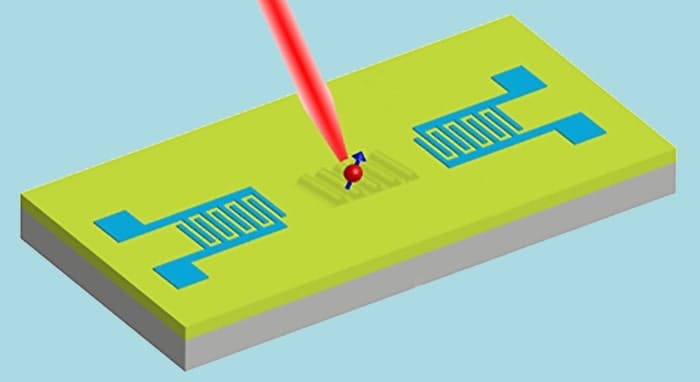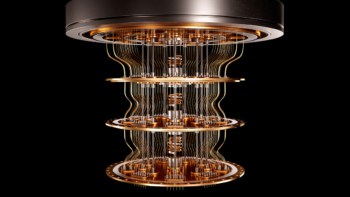
A new method to read out the spin states of individual negatively-charged nitrogen vacancy (NV–) centres has been developed by researchers in Europe and Japan. The technique could make today’s bulky read-out systems obsolete and enable new uses of NV– centres in electronic devices. It could also be used to read-out NV- centres that are very close together, which could be useful for developing quantum-information technologies.
A nitrogen vacancy occurs when two adjacent carbon atoms in a diamond lattice are replaced by a nitrogen atom and an empty lattice site. Together, the nitrogen atom and the vacancy can behave as a negatively-charged entity with an intrinsic spin. NV– centres are isolated from their surroundings, which means that their quantum behaviour is not immediately washed out by thermal fluctuations. As a result, they can be used to create a range of quantum technologies that operate at room temperature.
A green photon hitting an NV– centre can promote an electron to an excited state. As it decays back to the ground state, it may emit a red photon. The NV– centre has three spin sublevels, whose excited states have different probabilities of emitting a photon when they decay. By exciting an individual NV– centre repeatedly and collecting the red photons emitted, therefore, researchers can detect its spin state – which is extremely useful for quantum computation. Moreover, because the spin state can be influenced by external variables such as magnetic field, electric field, temperature, force and pressure, NV– centres can therefore been used as atomic-scale sensors.
Bulky detection
Although NV– centres are tiny, the equipment required to collect the red photons is bulky and complicated. This has prevented the integration of NV– centres into chip-sized devices. It also poses a problem for using NV– centres in room-temperature quantum computing. Entangling two NV– centres requires them to be about 30 nm apart, which is much smaller than the diffraction limit for red light. As a result, detecting the spin states separately requires difficult and expensive microscopy techniques.
Also, the finite lifetime of the excited state slows down experiments: “To get information about the NV centre’s spin state, you have to repeat the measurement many times,” explains Milos Nesladek of Hasselt University in Belgium: “You can put in only a certain amount of laser power before the optical signature saturates.”
Nesladek and colleagues have created an alternative method of detecting an NV- centre’s spin that also uses green laser light. However, the same physics that causes the excited states of NV– centres with different spins to have different fluorescence on decay also causes them to have different probabilities of absorbing a second photon from the same laser. This removes the extra electron from the NV– centre into the conduction band of the diamond. If a voltage is applied, the electron can move freely through the diamond and be detected. Measuring the photocurrent produced when light hits a specific NV– centre therefore allows researchers to infer its spin state. This process was first unveiled by Nesladek and colleagues in 2015 for NV– centre ensembles. The new work extends this to detection of single NV– centre spins.
Stronger signal
The researchers demonstrated a higher signal-to-noise ratio than possible with optical detection under the same conditions. Furthermore, they found that, as the photocurrent was produced when electrons were promoted from the excited state rather than when they decayed from it, it continued to increase when they turned up the laser power. Most importantly, says team member Petr Siyushev of the University of Ulm in Germany, “you don’t need to implement complicated optical detection: you can just integrate everything into a tiny diamond chip which will be compatible with all current electronic technology”.

Diamond quantum bit is controlled using light and sound
Ronald Walsworth of Harvard University in the US describes the work as “a very important technical step.” He cautions that the optics required to target specific NV– centres with green light are still quite complex, and says electrical readout presents its own difficulties: “You need to fabricate electrodes in specific places on the diamond,” he says. “Once you do that you can’t easily image many NVs over a wide field of view.” Nevertheless, he believes the technique has real promise for applications such as use of NV centres in cryogenics: “Getting good optical detection of red photons coming all the way out of a cryostat is a real challenge,” he says, “With electrical detection that would become very straightforward.”
The research is described in Science.



